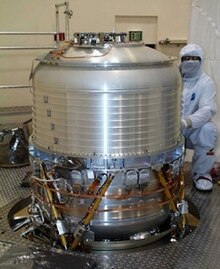Cryostat

A cryostat ( Greek κρύος , cold) is a cooling device that can be used to reach very low temperatures and keep them constant. Cryostats and the like are used. a. in low temperature physics , superconducting technology and for cooling infrared detectors.
Cooling principle
A distinction is made between bath cryostats, evaporator cryostats, mixture cryostats and refrigerator cryostats.
In the bath cryostat , the object to be cooled is surrounded by a cryogenic liquid. Liquid nitrogen (boiling temperature: −195.8 ° C / 77.4 K ) or liquid helium (boiling temperature: −268.93 ° C / 4.2 K) are often used as cryogenic liquids .
In the evaporator cryostat , cooling takes place with cold gas that is generated by evaporating and heating a cryogenic liquid. As a result, temperatures between just above the boiling point of the cryogenic liquid and room temperature can be set in the evaporator cryostat. Temperatures below the boiling point of the cryogenic liquid can be achieved by reducing the pressure above the cooling liquid and the associated lowering of the boiling point (see vapor pressure ).
Mixture cryostats generate low temperatures in the millikelvin range. The thermodynamic phase transition between a 3 He-rich and 3 He-poor phase is used in the 3 He- 4 He mixed cooling .
In the refrigerator cryostat , cooling is carried out by a small cooler ( cryocooler ) and therefore without cryogenic liquid.
construction
In order to be able to cool the cryostat with as little energy as possible, very good thermal insulation is necessary. The heat input by convection is reduced by installing the cold components in an evacuated container. The cold components are fastened to the warm outer container to reduce heat conduction in as few places as possible with suspensions and supports with low thermal conductivity . The heat radiation is reduced by either actively cooled or passive heat radiation shields built into the evacuated space. The passive heat radiation shields used are often metal-coated plastic films layered 10 to 30 times on top of each other, the so-called super insulation . In addition, the entire cooling system of the cryostat must be 100 percent gas-tight , otherwise the entire process will collapse.
The shape of the cryostat is adapted to its particular task. So are z. B. Cryostats for measurements in magnetic fields are adapted to the opening of the measuring magnet and cryostats for optical measurements are equipped with windows for the measuring beam.
application

Cryostats are used to investigate or use low-temperature phenomena: e.g. B. to
- Material investigation
- Microtome for cutting frozen specimens in histotechnology and biology
- Cooling of radiation sensors
- Photo receiver for medium infrared
- Image sensors for low-noise thermal imaging cameras
-
SQUID systems for:
- Magnetoencephalography
- Magnetocardiography
- superconducting quantum computers
- Cooling of superconducting coils
- in medical technology magnetic resonance imaging (MRT)
- in basic research ( magnets up to 19 Tesla ): synchrotrons , NMR spectroscopy , fusion reactors
See also
literature
- Jack W. Ekin: Experimental Techniques for Low Temperature Measurements: Cryostat Design, Materials, and Critical-Current Testing. Oxford University Press (2006), ISBN 978-0-19-857054-7
Web links
Individual evidence
- ↑ a b c d Karl Jousten: Wutz manual vacuum technology: theory and practice . 9. revised u. exp. Edition. Vieweg + Teubner Verlag, 2006, ISBN 978-3-8348-0133-3 ( p. 409 in the Google book search).
- ↑ Christian Enss, Siegfried Hunklinger : Low temperature physics . Springer, 2000, ISBN 978-3-540-67674-4 , pp. 372 .
- ↑ B. Renard, G. Dispau et al. a .: Ten years of cryomagnetic W7-X test facility construction and operation. In: Cryogenics. 51, 2011, pp. 384-388, doi: 10.1016 / j.cryogenics.2011.03.005 .

